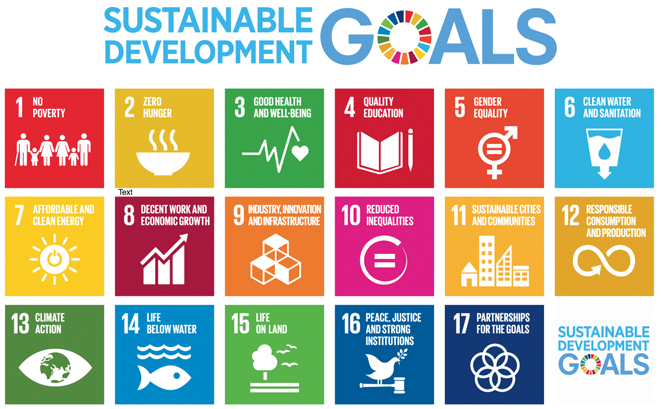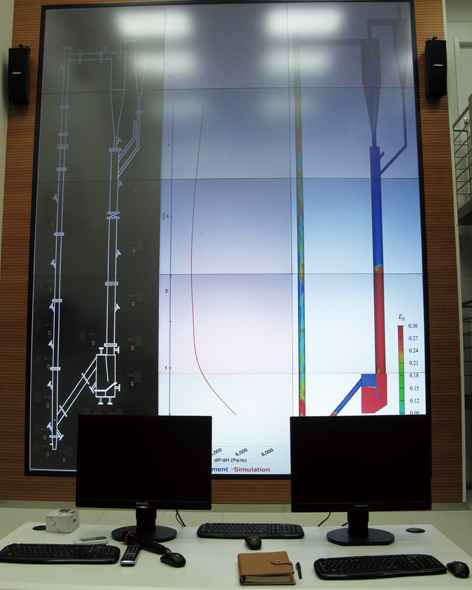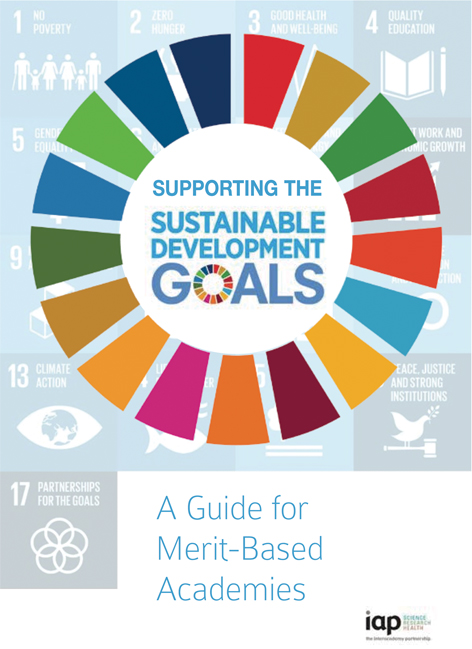By SONG Jianlan (Staff Reporter)
The United Nations’ 2030 Agenda for Sustainable Development, or “Agenda 2030”, is a blueprint for the future wellbeing of humankind. Particularly, it is underpinned by 17 Sustainable Development Goals (SDGs), which are further derived into 169 specific targets. Achieving these aspirational targets requires the best knowledge, innovation and application from all sectors of the planet, and hence scientific inputs are strongly called for to tackle the economic, social and environmental stresses. A vital factor for this is the participation of science in policy-making for human efforts to attain the grand goal of sustainable development. A program run by the Inter-Academy Partnership (IAP) is now on going to improve scientific inputs to the global policy making aimed at SDGs.

To end poverty, protect the planet and ensure that all people enjoy peace and prosperity, a collection of 17 Sustainable Development Goals was endorsed by the UN General Assembly in 2015. (Image: IAP)
“Process Tower,” the name of the main building of the Institute of Process Engineering (IPE), Chinese Academy of Sciences, might sound somewhat curious to many people, same as the discipline after which the Tower is named: process engineering. Headquartered in this building, IPE is a science institute committed to recasting industrial production with clean and energy-efficient technologies, including energy chemical engineering, biochemical engineering, material chemical engineering, resources and environment engineering, aimed at converting substances via green processes. Sprouting from an institute formerly focusing on chemical metallurgy – a discipline oriented to traditional industrial manufacturing, the renaissance of IPE miniatures the call for science input in the nation’s efforts to convert its industries onto a green track, taking science as a vehicle.

Participants on a lab tour at IPE. Prof. LI Jinghai, co-chair of the IAP program is seen giving a brief introduction of the virtual process engineering platform, which simulates green industrial processes in a smart way. (Photo by courtesy of IPE)
This makes the Tower a perfect venue to host a working group meeting of a project initiated by the InterAcademy Partnership (IAP), of which the Chinese Academy of Sciences (CAS) is a member. As an effort to help attain the 17 Sustainable Development Goals (SDGs) of the UN 2030 Agenda for Sustainable Development via strengthening the role of national science academies in global policymaking, the project, titled “Improving Scientific Input to Global Policymaking: Strategies for Achieving the Sustainable Development Goals” (Project), invokes the national academies of sciences under the umbrella of IAP to contribute their ideas about strategies for attaining SDGs. Led by a working group co-chaired by CAS Member Prof. LI Jinghai, Vice President of ICSU and former Vice President of CAS, and Dr. Eva Alisic, Senior Research Fellow at Monash University and past co-chair of the Global Young Academy, the project seeks to develop a framework for action that strengthens the global science-policy interface and facilitate productive collaboration and adoption of best practices among the organizations that generate scientific advice.


The “Process Tower,” the main building of IPE. (Photo by courtesy of IPE)
Enhancing the Role of Science in Global Policymaking towards SDGs
The United Nations’ 2030 Agenda for Sustainable Development, or “Agenda 2030”, is a blueprint for the future wellbeing of humankind. Particularly, it is underpinned by 17 SDGs, which are further derived into 169 specific targets. Achieving these aspirational targets requires the best knowledge, innovation and application from all sectors of the planet, and hence scientific inputs are strongly called for to tackle the economic, social and environmental stresses that are striking the planet. A vital factor for this is participation of science in policy-making for the human efforts to attain the grand goal of sustainable development of the planet.
The InterAcademy Partnership (IAP), formed by joining three inter-academy networks, namely the InterAcademy Council, IAP – The Global Network of Science Academies, and the InterAcademy Medical Panel, is a global network of science, medical, and engineering academies that works to support the role of science in seeking solutions to the world’s most challenging problems. Currently it has a total of 136 member academies, which together reach governments that represent 95 percent of the world’s population.
A key objective of the project is to strengthen the global science community’s capacity to support the implementation of the SDGs, with a focus on how the science academies can play their parts in this system to improve their inputs to the global policy landscapes of SDGs. In 2016, IAP for Research, a component of the Partnership, launched the three-year Project with financial support from the Carnegie Corporation of New York, and subsequently a working group was set up comprised of 11 internationally renowned scientists. From November 2016 to March 2017, the working group conducted a survey of IAP member academies to assess to what extent its member academies are supporting SDGs, and listen to their insights in global policy making in implementing SDGs.
“IAP launched the project to explore how national science academies could play a role in the process of achieving UN SDGs. This is a timely action by the Academies, since science – scientific thinking and scientific policymaking – plays an irreplaceably vital role in global sustainable development,” explained Prof. LI Jinghai, co-chiar of the project.
Included in the framework of the Project are some modules of actions and products, including a guide for SDGs tailored for the member academies; a searchable database containing academy reports related to SDGs contributed by member academies; and national, regional and global case studies and pilots conducted around the world. Finally, lessons learned and good practices and principles will be reviewed and summarized in the final report for the project. At the end of the Project, the Final Report will be submitted to the IAP-Research Board, the sponsor of the Project, and Carnegie Corporation of New York, the funder.
Before meeting in Beijing, the working group had met in New York in 2016 and Paris in 2017 respectively, and produced a report drawing on insights and perspectives from experts around the world. Based on the report from the Second Working Group Meeting held in February 2017 in Paris, at the Beijing Meeting the participants reviewed the progress of the project, and discussed the framework of the final report of the project.

Discussion in progress. (Photo by courtesy of IPE)
Apart from working group members and the project secretariat, the meeting in Beijing also brought together IAP regional network representatives and other experts from IAP member academies. At the meeting, they reported on their national and international outreach activities, as well as their own interactions with their own national academies and governments, focusing on insights and perspectives from the involved parties concerning strategies for achieving SDGs. The experts also discussed how the academies might contribute to the mapping and delivery of the Global Sustainable Development Report 2019, a UN publication to be completed in March 2019.
Also discussed at the meeting were the role of a 21st century academy of science, which could inform the agenda for the triennial conference of IAP scheduled in 2019, and the next steps of
China’s Perspectives on Implementing SDGs
Highlighted at the meeting were invited experts from China who have been working to achieve SDGs, to provide insights and perspectives from this country. Among them was Prof. ZHANG Linxiu, Director of the Center for Chinese Agricultural Policy, CAS, and a professor researcher working at the CAS Institute of Geographic Sciences and Natural Resources Research. ZHANG has been working for years in rural China in promoting health, nutrition and education interventions to enhance human resource development, as an effort to reduce poverty via capacity building of local communities.
In her presentation, she introduced her team’s action research on early childhood development (ECD) in poor rural communities of suburban Xi’an, a rapidly growing city in western China. Citing research published in Lancet, Prof. Zhang emphasized that investing in early children development can have positive spillovers. “It can not only enhance the human capital of developing countries, but also help to break the intergenerational poverty cycle,” she asserted.
Quality ECD service, particularly if provided in the first 1,000 days of infants, would be the most cost-efficient and rewarding investment in human capital development, she insisted. Based on their years-long research, they submitted a suggestion to the central government on strengthening governmental investment in ECD and, to their happiness and relief, got favorable responses from the senior leadership of the State.
“Now the government has started pilot projects for ECD in some rural areas,” she introduced with optimism. “Given the significant role of high quality human resources in economic contributions and hence sustainable development, timely ECD investment could help the people in rural China get rid of poverty and build up local capacity in poverty eradication,” she reiterated.
Prof. LI Yingming, an expert focusing on policy for sustainable development from the CAS Institutes of Science and Development (CASISD), gave a lecture on path dependency of policy-making for sustainable development (SD) and ecological civilization (EC) in China.

Cover of the guide to SDGs published by the IAP project “Improving Scientific Input to Global Policymaking: Strategies for Achieving the Sustainable Development Goals.”
LI elaborated on China’s signature shift from a GDP-centered path to a mode dominated by a protection-first philosophy. “For China, sustainable development has been a long-term strategy since the 1990s,” she continued, when reviewing the emergence of EC as the leading concept for this country’s sustainable development until 2050. “As a core component of EC,” she emphasized: “the green transition/development and a structural change are crucial in a new era of socio-economic development.” For this sake, great efforts needed to be made in upgrading industries onto a green track, including improving resource/energy efficiency, environmental service, clean energy, new energy vehicle industry, and so on, she explained.
In her speech, she introduced the comprehensive measures taken in China to ensure the implementation of the new development philosophy, giving specific details in aspects of legal, planning, policy and social frameworks. In particular, she reported the new approach to EC adopted in China since the 19th CPC Congress, including the system of strategies and targets in the new era of socialist modernization with Chinese characteristics.

Participants in the meeting. (Photo by courtesy of IPE)
Such a socio-economic transition, she reiterated, would entail in-depth structural reform of the whole society, including greening reform from the supply side and institutional reform aimed at social governance transition.
Following the speeches made by Chinese scholars, experts from Asia, Africa and Pan-Pacific areas offered their insights on potential policy solutions, and gave advice on how to enhance the role of science in policymaking, focusing on some similar issues currently confronting China, like pollution control, strategies for reduction of redundant capacity, and improvement of industrial structure.
Searchable Database and Brief Guide for SDGs
Presently, a searchable database is being developed under the Project’s framework, to provide reports contributed by IAP member academies that are either directly or indirectly relevant to SDGs.
The database is intended to be an open-access resource for all stakeholders, setting out where academies and their members bring knowledge to support the SDGs and where there is capacity to inform policy-making.
As shown in the survey conducted by the Project, awareness of SDGs in IAP member academies, including senior national academies, national young academies and the Global Young Academy (GYA), is limited. This raised concerns in the scientific community, and the surveyed institutions requested more clarity on how UN processes and structures support the SDGs, and where and how academies can participate in.
In response to their requests, the Project developed a brief guide for SDGs in the title “Supporting the Sustainable Development Goals: A Guide for Merit-Based Academies,” and released it online on December 6, 2017 at the official website of IAP: http://www.interacademycouncil.net/24026/IAP_SDG_Guide.aspx.
Answering requests from the merit-based academies, publication of the guide to the SDGs is anticipated to set out in a simple and succinct way why and how the global science community can support the SDGs nationally, regionally and globally.
The Beijing session of the Working Group meeting produced a discussion paper for IAP’s consideration, together with plans for the remainder of the Project, and suggested topics for the IAP Triennial Conference and General Assembly, which is to occur in 2019.
Following the Beijing Meeting, four regional meetings are to be held the first half of 2018, in partnership with the IAP regional networks, namely NASA – Africa, IANAS – Americas, AASSA – Asia and EASAC – Europe. As planned, the national, regional and global case studies and experiments will go on in the upcoming year, with an objective to illustrate examples of good practice within or between academies, and facilitate at the science-policy interface by helping individual academies and/or IAP’s global initiatives to reach their audiences at the national and/or global level.”

